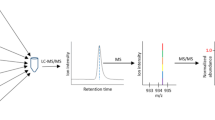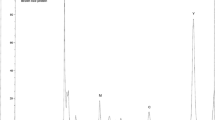Abstract
A method for determining residual protein in commercial human milk oligosaccharides is described. Size exclusion chromatography is used to separate any protein from the oligosaccharides, and UV absorbance is used to estimate its concentration. The analysis is calibrated with casein-spiked oligosaccharide solutions, with protein mass fractions at 5 mg/kg–100 mg/kg of oligosaccharide (or when expressed as mass/volume of calibration solution, 0.75 mg/L–15 mg/L). Method performance was defined by assessments of linearity (correlation coefficient ≥ 0.998; residuals from -2.9 % to -5.6 %); reproducibility (analyses of multiple lots of oligosaccharides, with and without a quantifiable protein presence); accuracy (verification by three alternate methods); selectivity (reagent blanks and peak area ratio); and limits of quantitation and detection (~ 5 mg/kg and ~ 2 mg/kg, respectively, as mass fraction protein/oligosaccharide). The method provides a simple means for determining residual protein in oligosaccharides, capable of quantifying low protein levels (e.g., 5 mg/kg oligosaccharide) in the presence of a high oligosaccharide concentration (150 g/L, the HMO mass/volume in the prepared sample) by conventional LC/UV.
Graphical abstract





Similar content being viewed by others
References
Priem B, Gilbert M, Wakarchuk WW, Heyraud A, Samain E (2002) A new fermentation process allows large-scale production of human milk oligosaccharides by metabolically engineered bacteria. Glycobiol 12:235–240
Kuntz S, Rudloff S, Kunz C (2008) Oligosaccharides from human milk influence growth-related characteristics of intestinally transformed and non-transformed intestinal cells. Br J Nutr 99:462–471
Barile D, Tao N, Lebrilla CB, Coisson JD, Arlorio M, German JB (2009) Permeate from cheese whey ultrafiltration is a source of milk oligosaccharides. Int Dairy J 19:524–530
Drouillard S, Mine T, Kajiwara H, Yamamoto T, Samain E (2010) Efficient synthesis of 6’-sialyllactose, 6,6’-disialyllactose, and 6’-KDO-lactose by metabolically engineered E. coli expressing a multifunctional sialyltransferase from the Photobacterium sp. JT-ISH-224. Carbohydrate Res 345:1394–1399
Lee WH, Pathanibul P, Quarterman J, Jo JH, Han NS, Miller MJ, Jin YS, Seo JH (2012) Whole cell biosynthesis of a functional oligosaccharide, 2’-fucosyllactose, using engineered Escherichia coli. Microb Cell Fact 11:48
Baumgartner F, Conrad J, Sprenger GA, Albermann C (2014) Synthesis of the human milk oligosaccharide lact-N-tetraose in metabolically engineered, plasmid-free E. coli. ChemBioChem 15:1896–1900
Bode L, Contractor N, Barile D, Pohl N, Prudden AR, Boons GJ, Jin YS, Jennewein S (2016) Overcoming the limited availability of human milk oligosaccharides: challenges and opportunities for research and application. Nutr Rev 74:635–644
Zeuner B, Teze D, Muschiol J, Meyer AS (2019) Synthesis of human milk oligosaccharides: Protein engineering strategies for improved enzymatic transglycosylation. Molecules 24:2033
Weichart S, Jennewein S, Hufner E, Weiss C, Borkowski J, Putze J, Schroten H (2013) Bioengineered 2-fucosyllactose and 3-fucosyllactose inhibit the adhesion of Pseudomonas aeruginosa and enteric pathogens to human intestinal and respiratory cell lines. Nutr Res 33:831–838
Choi YH, Park BS, Seo JH, Kim BG (2019) Biosynthesis of the human milk oligosaccharide 3-fucosyllactose in metabolically engineered Escherichia coli via the salvage pathway through increasing GTP synthesis and β-galactosidase modification. Biotechnol Bioeng 116:3324–3332
Nowak-Wegrzyn A, Shapiro GG, Beyer K, Bardina L, Sampson HA (2004) Contamination of dry powder inhalers for asthma with milk proteins containing lactose. J Allergy Clin Immunol 113:558–560
Eda A, Sugai K, Shioya H, Fujitsuka A, Ito S, Iwata T, Funabiki T (2009) Acute allergic reaction to milk proteins contaminating lactose added to corticosteroid for injection. Allergology Int 58:137–139
Yan R, Qu L, Luo N, Liu Y, Liu Y, Li L, Chen L (2014) Quantitation of α-lactalbumin by liquid chromatography tandem mass spectrometry in medicinal adjuvant lactose. Int J Anal Chem, 841084
U.S. Pharmacopeia/National Formulary (2016) Residual host cell protein measurement in biopharmaceuticals. USP 39 NF 34. United States Pharmacopeial Convention, Rockville, MD, USA
Banik SP, Pal S, Ghorai S, Chowdhury S, Khowala S (2009) Interference of sugars in the Coomassie Blue G binding assay of proteins. Anal Biochem 386:113–115
Swaisgood HE (1995) Protein and Amino Acid Composition of Bovine Milk. In: Jensen RG (ed) Handbook of Milk Composition. Academic, San Diego, p 465
The UniProt Knowledgebase (UniProtKB) (2020) www.uniprot.org
Johns PW, Jacobs WA, Phillips RR, McKenna RJ, O’Kane KA, McEwen JW (2011) Characterisation of peptide molecular mass distribution in commercial hydrolysates and hydrolysate-based nutritional products. Food Chem 125:1041–1050
Bond MD, Panek ME, Zhang Z, Wang D, Mehndiratta P, Zhao H, Gunton K, Ni A, Nedved ML, Burman S, Volkin DB (2010) Evaluation of a dual-wavelength size exclusion HPLC method with improved sensitivity to detect protein aggregates and its use to better characterize degradation pathways of an IgG1 monoclonal antibody. J Pharm Sci 99:2582–2597
Anthis NJ, Clore GM (2013) Sequence-specific determination of protein and peptide concentrations by absorbance at 205 nm. Prot Sci 22:851–858
Sindayikengera S, Xia WS (2006) Nutritional evaluation of caseins and whey proteins and their hydrolysates from Protamex-. J Zhejiang Univ Sci B 7:90–98
Author information
Authors and Affiliations
Corresponding author
Ethics declarations
Conflicts of interest
Paul W. Johns declares that he has no conflict of interest.
Additional information
Publisher's Note
Springer Nature remains neutral with regard to jurisdictional claims in published maps and institutional affiliations.
Rights and permissions
About this article
Cite this article
Johns, P.W. Determination of residual protein in commercial human milk oligosaccharides. Accred Qual Assur 26, 261–269 (2021). https://doi.org/10.1007/s00769-021-01481-9
Received:
Accepted:
Published:
Issue Date:
DOI: https://doi.org/10.1007/s00769-021-01481-9




